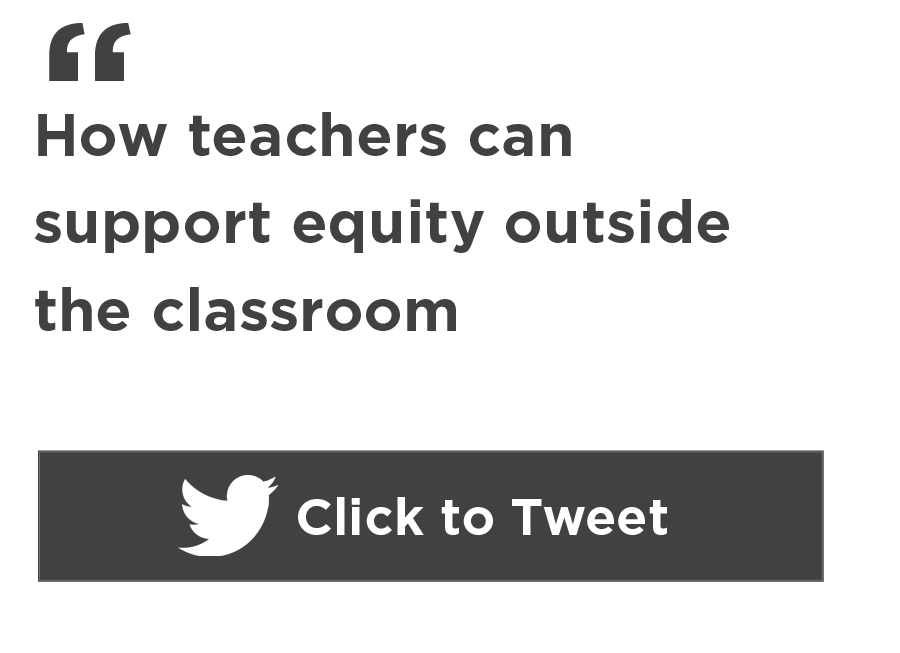The classroom is a powerful place to effect positive change in the world. You know that, of course, and that’s why you do the work you do. But is there anything you can be doing outside of school? For me, my fourth and final shift aimed at helping me reshape my teaching practice is about exactly that.
Shift #4: Participate in or financially support organizations creating new pathways to anti-racist change
Although I saved this idea for last, to me this is one of the most critical aspects of what working to be an anti-racist educator means. In addition, I feel it is my obligation, as a white person, to be working to undo racism on a larger level than in just my own sphere.
I have often noticed, in conversations with well-intentioned white colleagues and peers, that people find it easy to engage in issues of equity in the workplace, yet ignore the personal and community work that is a truly necessary part of the whole. For example, of the over 100 adults who work as faculty or staff at my school, only a small percentage send their children to schools within our district (they choose the whiter, wealthier suburbs where most faculty live instead). This is not an indictment of these individuals but rather a critique of the larger structure of white supremacy culture, which allows white people to escape from facing the reality of racism every day. Even though many of my colleagues are deeply invested in doing equity work at our school, it can become difficult for us to see how to engage in that work on a truly personal level. That is, how do we do the work once we leave the building (or online classroom) and there is less structure—and less required of us?
For me, it feels vital to live my practice as an (always aspiring to be) anti-racist educator in my whole life, in all the communities of which I am a part. If you are looking to develop this capacity, here are a few starting points for engaging with anti-racism work outside of school. These are listed from least amount of effort required to greatest.
Donate your money
This is the easiest, least personal way of engaging and yet is critical in upending white supremacy. There are a huge number of places to support, and I strongly encourage looking for places that were created by and are led by people of color. Even small donations are helpful and sustaining (monthly) ones are especially important. Bonus points if you donate anonymously and get someone else to donate, too. If you feel stuck about where to begin, here are some places I’ve donated to or will support in the coming year:
Participate in local initiatives
Support efforts that already exist by volunteering your time and energy. This means connecting with people in your community and finding out where help is needed, not starting your own initiative based on what you think is best. It means going beyond putting a sign in your front yard and doing work with others in your community. Mutual aid funds, community organizations doing outreach and support, educational programs, and initiatives that provide meals and organize donations are all excellent causes to find and support. Start by Googling volunteer opportunities based on your interests or searching a site like VolunteerMatch. Or connect with your local Showing Up for Racial Justice (SURJ) chapter. They’ll help you get plugged in.
In closing
Last year, despite many of the terrifying and sad things in the world, my partner and I decided to get pregnant. We welcomed our son in June. To be honest, the world seemed to get so much darker during my pregnancy. I entered my third trimester as my school district shut down because of coronavirus. I thought back to 2019, when I’d read the introduction to adrienne maree brown’s Emergent Strategy. In it, she describes having hope and optimism in the world. But in that moment, her vision seemed distant from me and impossible. How, I thought, could I have hope at a time like this?
Two years ago, I had the honor to create and chaperone a trip to the Equal Justice Initiative’s Legacy Museum and Memorial for Peace and Justice with 11 students and three colleagues (in fact, NWEA provided the full funding needed for us to repeat that trip in 2020. It’s still on hold because of coronavirus). While on the trip, one of the most important themes in our conversations was the incredible, dazzling sacrifices that people have continued to make in the name of justice. I listened as the young people in my group committed themselves, with a serious kind of joy, to taking risks. How could I not be willing to continue to take my own?
I do not think this time is just about being hopeful (and to be clear, that’s not what adrienne maree brown describes either). It is only through taking significant, challenging risks that I can hope for the world I would like to see emerge. This series of blog posts is tiny in the face of the larger risks and contributions that I expect of myself—for the sake of my own humanity, for the future of my child and the futures of my students, for the pursuit of justice and a safer, more equitable world for all. I hope it helps you in your journey to do the same.
This is the last in a five-part series on anti-racist teaching. Read the introductory post, part 2, part 3, and part 4.









